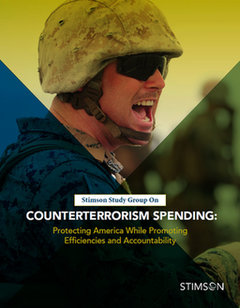data
The cost of counterterrorism: US spending from 9/11 until now
A new report from the Stimson Center has provided an initial tally of total US counterterrorism spending since 9/11. We take a look at the findings to identify spending trends.
Ever since the attacks on the World Trade Center in September 2001, counterterrorism efforts have become perhaps the predominant military focus in the US, both in defending against attacks at home and in efforts abroad.
These efforts have required huge amounts of resources, both financially and in terms of manpower, but a fully accurate measure of how much the US has spent on the fight against terrorism has been missing.
Now a new report from the Stimson Center, a nonpartisan policy research centre, has provided an initial tally that may allow policymakers to make more accurate judgement of the efficiency of efforts so far and to determine where to best direct resources in the future.
Overseas Contingency Operations dominate spending composition
Sometimes referred to as war funds, the overseas contingency operations (OCO) fund is used as a separate source of funding to the Department of Defense and the State Department’s ‘base’ budgets. Originally used to finance the wars in Iraq and Afghanistan, the fund has continued to be a source of finance, primarily for the Pentagon.
The term ‘global war on terror’ was replaced by ‘overseas contingency operation’ in March 2009, a designation perhaps indicative of the general stepdown in counterterror spending following a 2008 peak of $259bn. Nevertheless and perhaps predictably, OCO spending, considered by some to essentially be a Pentagon slush fund, has remained the principal outflow of finance, making up 60% of counterterror spending from 2002-2017.
Counterterrorism spending has risen more sharply than overall discretionary spending
As a whole, defence spending has risen rapidly since 9/11 but counterterrorism operations have seen a far sharper rise than the overall spending that is appropriated annually. At the peak of spending in 2008, counterterror spending had increased by 277% compared to the overall discretionary increase of 116%.
In large part this is due to war, $1.8tn has been spent in Afghanistan, Iraq and Syria alongside other counterterror operations since 9/11, but it is notable that, while both forms of spending largely rise and fall in parallel, counterterror funding saw such a clear increase in priority versus other defence concerns.
Overlap between OCO and counterterror spending demonstrates a need for greater transparency
One of the major differences between standard discretionary spending and that designated as OCO is that discretionary spending was put under caps in the Budget Control Act of 2011. OCO’s freedom from those caps has allowed administrations to circumvent budget constraints in a manner that calls transparency into question.
With the Department of Defense’s non-war OCO spending growing from $10bn to $18bn between fiscal years 2014 and 2017, questions must be raised over the accuracy of how OCO spending is categorised. This also strengthens the argument that counterterror and OCO spending needs to be defined more clearly in order to better account for the overall cost of counterterror spending.
Homeland security spending over time may indicate lack of efficiency
Predictably, homeland security saw a huge boost in spending following the 9/11 attacks with spending specifically directed towards border and transportation security. Border and transportation spending accounted for $379bn (39%) from 2002-2017, while the protection of critical infrastructure accounted for $314bn (32%).
Although it is to be expected that these areas would be of particular importance, it is notable that their share of homeland security spending was either the same in 2017 as in 2002 (critical infrastructure: 30% in both years) or has only negligibly shifted (border and transportation: 42% in 2002 and 43% in 2003). Given the general downturn of counterterror spending, it is perhaps strange for these categories to remain so stable in their share of spending and could, according to the Stimson report, suggest a possible lack of efficiency.
Conclusions: counterterrorism spending is vast yet lacks clear definition or transparency
The Stimson report found that $2.8tn had been spent on counterterrorism between 2002 and 2017, yet noted that, due to shifting definitions and data inconsistencies, it cannot guarantee that this figure is not an over or understatement. As such, while the report is likely the most comprehensive analysis of such spending yet compiled, its findings suggest that there is a significant need for greater accountability and transparency.
In addition to a need for Congress to create its own counterterrorism funding report through the Office of Management and Budget, the report highlights the requirement to establish clear definitions and accounting structures. The vagueness of certain official definitions regarding spending, in particular that classed as OCO, makes it hard to see just where the money broadly categorised as for counterterrorism operations is going and how effectively it is being spent.
With war spending also lumped into the pot, the report recommends that, if Congress is to more effectively and systematically evaluate where the money is actually going, it is crucial that counterterrorism spending ceases to be such a blanket category and is instead approached at the program, activity, and project level with far increased clarity.

/ All data courtesy of Stimson Center
go to top